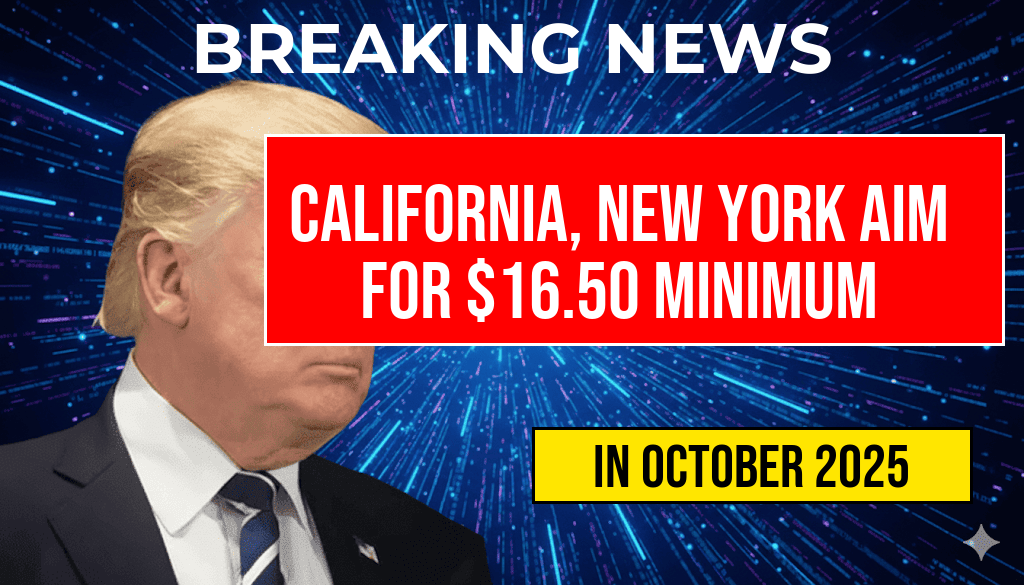California and New York are moving closer to implementing a $16.50 hourly minimum wage, a significant increase aimed at addressing rising living costs and economic disparities. Both states have announced plans to phase in this higher wage rate over the coming years, reflecting ongoing efforts to boost income levels for low-wage workers amid inflationary pressures. California’s proposed increase aligns with recent legislative actions, while New York has outlined a multi-year schedule to reach the target figure, which surpasses current state minimum wages by several dollars. These developments come as policymakers seek to balance economic growth with wage fairness, positioning both states at the forefront of the national movement toward better compensation standards. The planned adjustments are poised to impact millions of workers, potentially reshaping local labor markets and influencing regional economic dynamics.
California’s Path Toward a $16.50 Minimum Wage
California has long been a leader in setting progressive wage policies, with the current minimum wage varying by region and employer size. The state’s Department of Industrial Relations (DIR) announced a plan to increase the minimum wage to $16.50 per hour by 2024 for large employers, with smaller businesses gradually following suit over subsequent years. The timeline reflects a strategic approach aimed at easing the transition for businesses while providing wage increases for workers.
Under California’s phased plan, the minimum wage will reach $15.50 per hour by January 2023 for employers with over 25 employees, then incrementally increase to the target of $16.50 by January 2024. Smaller firms will see comparable increases, culminating in the same rate within a year or two thereafter. This step-by-step process aims to minimize economic disruptions while ensuring workers receive substantial wage improvements.
Legislators highlight that the move aligns with California’s broader goal of reducing income inequality and supporting low-wage earners. The increase is also expected to influence local economies, as higher wages typically translate into increased consumer spending. Critics, however, express concern over potential adverse effects on small businesses, particularly in sectors heavily reliant on low-wage labor such as retail and hospitality.
New York’s Multi-Year Strategy to Reach $16.50
New York’s approach involves a structured plan to elevate the minimum wage to $16.50 an hour across different regions, with a focus on gradually phasing in the increase over several years. The state’s Department of Labor outlined a schedule that varies by location, with higher-cost areas like New York City adopting the higher wage sooner, while less expensive regions will follow a slower timeline.
| Region | 2023 | 2024 | 2025 |
|---|---|---|---|
| New York City | $15.00 | $16.00 | $16.50 |
| Long Island & Westchester | $14.00 | $15.50 | $16.50 |
| Upstate New York | $13.20 | $14.20 | $16.50 |
The phased increase aims to support regional economic stability while addressing disparities in living costs. Governor Kathy Hochul emphasized the importance of equitable wages in fostering economic resilience, noting that the targeted wage increase would benefit thousands of workers and their families.
Proponents argue that higher wages will reduce the reliance on public assistance programs, promote consumer spending, and stimulate local economies. However, opponents warn that rapid wage hikes could lead to increased labor costs for businesses, potentially resulting in higher prices or reduced employment opportunities in vulnerable sectors.
Impacts and Broader Implications
Economic and Labor Market Effects
- Potential increase in employment costs for small and mid-sized businesses.
- Possible shifts in employment patterns, with some firms adjusting hours or hiring fewer workers.
- Higher disposable income for low-wage workers, potentially boosting local economies.
- Reduction in income inequality and poverty levels, especially among frontline workers.
Policy Considerations and Challenges
- Balancing wage increases with business sustainability during economic recovery.
- Monitoring inflationary pressures linked to wage hikes.
- Ensuring that wage policies do not disproportionately impact small businesses or lead to job losses.
- Addressing regional disparities by tailoring wage schedules to local economic conditions.
Both California and New York are engaging with stakeholders, including business associations and labor unions, to refine implementation strategies and mitigate potential negative impacts. Experts suggest that careful oversight and adaptive policies will be crucial as these states navigate the transition to higher minimum wages.
As these plans unfold, they are expected to serve as models or points of comparison for other states contemplating similar wage increases. Broader discussions continue around the ideal balance between fair compensation and economic vitality, with California and New York taking prominent roles in shaping the national conversation.
For more on minimum wage policies and their implications, resources such as Wikipedia’s minimum wage entry and recent analyses from Forbes provide valuable context and updates.
Frequently Asked Questions
What is the new proposed minimum wage in California and New York?
The proposed minimum wage in both California and New York is set to reach $16.50 per hour.
When will the new minimum wage rates take effect?
The article discusses upcoming changes, with California and New York planning to implement the $16.50 per hour minimum wage within the next year, though specific dates may vary by region.
Who will be affected by the minimum wage increase?
The minimum wage increase will primarily impact low-wage workers across California and New York, including employees in retail, hospitality, and other service industries.
What are the potential benefits of increasing the minimum wage to $16.50?
Raising the minimum wage aims to improve living standards, reduce income inequality, and boost consumer spending within both states.
Are there any exceptions or phased plans for the minimum wage increase?
Some exceptions or phased implementation plans may be in place, especially for small businesses or certain regions, to ensure a smooth transition to the new wage standards.






